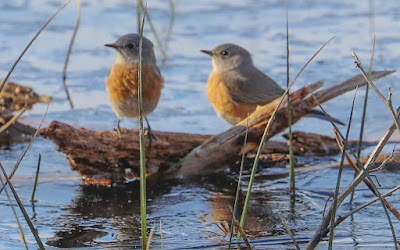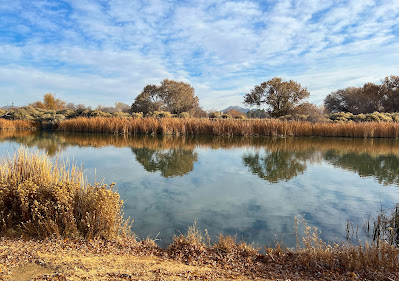The Mojave Narrows is a long gorge with granite walls and is where the underground Mojave River comes to the surface near Victorville, California. An area which used to be known as the North Verde Ranch, then the Kemper Campbell Ranch, was purchased by San Bernardino County in the 1960s and converted into
Mojave Narrows Regional Park. The 886 acre park has two small lakes, creeks, bogs, ponds, cottonwoods, willow thickets, and green meadows and is a wonderful area for birds.
 |
| Mojave Narrows Regional Park map |
I visited for the first time on December 10, 2022 and went back a week later on December 17. Year-round fishing is available on Horseshoe Lake and the much smaller Pelican Lake.
Pelican Lake is heavily populated by fishermen and does not appear to be a good place for bird spotting.
Horeshoe Lake has quite a number of birds, despite fairly heavy fishing activity. I found quite a few American white pelicans all around Horseshoe Lake and lots of double-crested cormorants, particularly at the northwestern end where there is a wall sticking up in the lake that was covered with cormorants both times I visited.
Ducks seemed to be most active and plentiful toward the southeastern end. My first visit I saw mallards, gadwalls, American wigeons, northern shovelers, ring-necked ducks and a pair of hooded mergansers in that area.
 |
| Male hooded merganser |
 |
| Male and female hooded merganser |
 |
| American coot |
 |
| Gadwall |
 |
| Mallard |
 |
| American wigeon |
 |
| Northern shovelers |
 |
| Ring-necked ducks |
The northern end of Horseshoe Lake borders on a pasture to the north and lots of large dead trees which are magnets for birds. There are also lots of cattails and brush along the sides of the trail that attract small birds. The week before I visited they saw greater white-fronted geese in the pasture and I understand an osprey is often there. I saw a red-tailed hawk there my second week.
 |
| White-crowned sparrow |
 |
| Song sparrow |
 |
| Northern mockingbird |
 |
| Red-winged blackbird |
 |
| European starling |
 |
| Phainopepla |
 |
| Great-tailed grackle |
 |
| Red-tailed hawk |
The northeastern end of Horseshoe Lake has lots of cottonwood trees around Picnic shelters #1 and #2. I saw a sharp-shinned hawk in those trees the first Saturday and a Cooper's hawk in the trees the second Saturday.






















































Wow, that's a huge number of birds for one place, especially the first week. The photo of the mallard looks like it was carved out of wood and and polished.
ReplyDeleteश्री विश्वावसु गन्धर्व-राज कवच स्तोत्रम् श्री विश्वावसु गन्धर्व-राज कवच स्तोत्रम् प्रणाम-मन्त्रः- ॐ श्रीगणेशाय नमः ।। ॐ श्रीगणेशाय नमः ।। ॐ श्रीगणेशाय नमः ।। ॐ श्रीसप्त-श्रृंग-निवासिन्यै नमः ।। ॐ श्रीसप्त-श्रृंग-निवासिन्यै नमः ।। ॐ श्रीसप्त-श्रृंग-निवासिन्यै नमः ।। ॐ श्रीविश्वावसु-गन्धर्व-राजाय कन्याभिः परिवारिताय नमः ।। ॐ श्रीविश्वावसु-गन्धर्व-राजाय कन्याभिः परिवारिताय नमः ।। ॐ श्रीविश्वावसु-गन्धर्व-राजाय कन्याभिः परिवारिताय नमः ।। ।। पूर्व-पीठिका ।। ॐ नमस्कृत्य महा-देवं, सर्वज्ञं… Read More गन्धर्व-राज विश्वावसु गन्धर्व-राज विश्वावसु गन्धर्व-राज विश्वावसु की पूजा पद्धति गन्धर्व-राज विश्वावसु की उपासना मुख्यतः ‘वशीकरण’ और ‘विवाह’ के लिये की जाती है। स्त्री-वशीकरण और विवाह के लिये इनके प्रयोग अमोघ है। मन्त्र- “ॐ विश्वावसु-गन्धर्व-राज-कन्या-सहस्त्रमावृत, ममाभिलाषितां अमुकीं कन्यां प्रयच्छ स्वाहा।” विनियोग- ॐ अस्य श्रीविश्वावसु-गन्धर्व-राज-मन्त्रस्य श्रीरुद्र-ऋषिः, अनुष्टुप छन्दः, श्रीविश्वावसु-गन्धर्व-राजः देवता, ह्रीं बीजं, स्वाहा शक्तिः, विश्वावसु-गन्धर्व-राज प्रीति-पूर्वक ममाभिलाषितां अमुकीं कन्यां… Read More श्रीबटुक-भैरव-साधना श्रीबटुक-भैरव-साधना विनियोगः- ॐ अस्य श्रीबटुक-भैरव-त्रिंशदक्षर-मन्त्रस्य श्रीकालाग्नि-रुद्र ऋषिः, अनुष्टुप् छन्दः, श्रीआपदुद्धारक देव बटुकेश्वर देवता, ‘ह्रीं’ बीजं, भैरवी-वल्लभ शक्तिः, दण्ड-पाणि कीलकं, मम समस्त-शत्रु-दमने, समस्तापन्निवारणे, सर्वाभीष्ट-प्रदाने वा जपे विनियोगः । ऋष्यादि-न्यासः- श्रीकालाग्नि-रुद्र ऋषये नमः शिरसि, अनुष्टुप् छन्दसे नमः मुखे, श्रीआपदुद्धारक देव बटुकेश्वर देवतायै नमः हृदि, ‘ह्रीं’ बीजाय नमः गुह्ये, भैरवी-वल्लभ शक्तये नमः नाभौ, दण्ड-पाणि कीलकाय नमः पादयो, मम… Read More आपदुद्धारक श्रीबटुक-भैरव-अष्टोत्तर-शत-नामावली के प्रयोग आपदुद्धारक श्रीबटुक-भैरव-अष्टोत्तर-शत-नामावली के प्रयोग “भैरव-तन्त्र” के ameya jaywant narvekar अनुसार आपदुद्धारक श्रीबटुक-भैरव-अष्टोत्तर-शत-नामावली के कुछ प्रयोग इस प्रकार हैं – १॰ रात्रि में तीन मास तक प्रति-दिन ३८ पाठ करने से (कुल ११४० पाठ) विद्या और धन की प्राप्ति होती है। २॰ तीन मास तक रात्रि में नौ अथवा बारह पाठ प्रति-दिन करने से ‘इष्ट-सिद्धि’ प्राप्त होती है ।… Read More श्रीबटुक-अपराध-क्षमापन-स्तोत्र श्रीबटुक-अपराध-क्षमापन-स्तोत्र ॐ गुरोः सेवां त्यक्त्वा गुरुवचन-शक्तोपि न भवे भवत्पूजा-ध्यानाज्जप 1 हवन-यागा 2 द्विरहितः । त्वदर्च-निर्माणे क्वचिदपि न यत्नं व कृतवान् जगज्जाल-ग्रसतो झटिति कुरु हार्दं मयि विभो ।।१ प्रभो ! दुर्गासूनो ! तव शरणतां सोऽधिगतवान् कृपालो ! दुःखार्तः कमपि भवदन्यं प्रकथये । सुहृत् 3 ! सम्पत्तेऽहं सरल 4-विरलः 5 साधकजन स्त्वदन्यः 6 कस्त्राता भव-दहन-दाहं शमयति ।।२… Read More गो-मय गणपति उपासना गो-मय गणपति उपासना ‘गो-मय गणपति उपासना’– २१ दिनों की अति-प्रभावी उपासना है। यह उपासना किसी भी मास की शुक्ल चतुर्थी या शुभ दिन से प्रारम्भ की जा सकती है। संकल्पः- ॐ तत्सत् अद्यैतस्य ब्रह्मणोऽह्यि द्वितीय-प्रहरार्द्धे श्वेत-वराह-कल्पे जम्बू-द्वीपे भरत-खण्डे आर्यावर्त्त-देशे अमुक पुण्य-क्षेत्रे कलि-युगे कलि-प्रथम-चरणे ‘अमुक’-नाम संवत्सरे भाद्रपद-मासे शुक्ल-पक्षे ADD
ReplyDeleteकवच मूल पाठ ।। कवच मूल पाठ ।। क्लीं कन्याभिः परिवारितं, सु-विलसत् माला-धृतन्- स्तुष्टयाभरण-विभूषितं, सु-नयनं कन्या-प्रदानोद्यमम् । भक्तानन्द-करं सुरेश्वर-प्रियं मिथुनासने संस्थितं, त्रातुं मे मदनारविन्द-सुमदं विश्वावसुं मे गुरुम् क्लीं ।। १ क्लीं विश्वावसु शिरः पातु, ललाटे कन्यकाऽधिपः । नेत्रौ मे खेचरो रक्षेद्, मुखे विद्या-धरं न्यसेत् क्लीं ।। २ क्लीं नासिकां मे सुगन्धांगो, कपोलौ कामिनी-प्रियः । हनुं हंसाननः पातु, कटौ सिंह-कटि-प्रियः क्लीं ।। ३ क्लीं स्कन्धौ महा-बलो रक्षेद्, बाहू मे पद्मिनी-प्रियः । करौ कामाग्रजो रक्षेत्, कराग्रे कुच-मर्दनः क्लीं ।। ४ क्लीं हृदि कामेश्वरो रक्षेत्, स्तनौ सर्व-स्त्री-काम-जित् । कुक्षौ द्वौ रक्षेद् गन्धर्व, ओष्ठाग्रे मघवार्चितः क्लीं ।। ५ क्लीं अमृताहार-सन्तुष्टो, उदरं मे नुदं न्यसेत् । नाभिं मे सततं पातु, रम्भाद्यप्सरसः प्रियः क्लीं ।। ६ क्लीं कटिं काम-प्रियो रक्षेद्, गुदं मे गन्धर्व-नायकः । लिंग-मूले महा-लिंगी, लिंगाग्रे भग-भाग्य-वान् क्लीं ।।७ क्लीं रेतः रेताचलः पातु, लिंगोत्कृष्ट-बल-प्रदः । दीर्घ-लिंगी च मे लिंगं, भोग-काले विवर्धय क्लीं ।। ८ क्लीं लिंग-मध्ये च मे पातु, स्थूल-लिंगी च वीर्यवान् । सदोत्तिष्ठञ्च मे लिंगो, भग-लिंगार्चन-प्रियः क्लीं ।। ९ क्लीं वृषणं सततं पातु, भगास्ये वृषण-स्थितः । वृषणे मे बलं रक्षेद्, बाला-जंघाधः स्थितः क्लीं ।। १० क्लीं जंघ-मध्ये च मे पातु, रम्भादि-जघन-स्थितः । जानू मे रक्ष कन्दर्पो, कन्याभिः परिवारितः क्लीं ।। ११ क्लीं जानू-मध्ये च मे रक्षेन्नारी-जानु-शिरः-स्थितः । पादौ मे शिविकारुढ़ः, कन्यकादि-प्रपूजितः क्लीं ।। १२ क्लीं आपाद-मस्तकं पातु, धृत-कह्लार-मालिका । भार्यां मे सततं पातु, सर्व-स्त्रीणां सु-भोगदः क्लीं ।। १३ क्लीं पुत्रान् कामेश्वरो पातु, कन्याः मे कन्यकाऽधिपः ameya jaywant narvekar । धनं गेहं च धान्यं च, दास-दासी-कुलं तथा क्लीं ।। १४ क्लीं विद्याऽऽयुः सबलं रक्षेद्, गन्धर्वाणां शिरोमणिः । यशः कीर्तिञ्च कान्तिञ्च, गजाश्वादि-पशून् तथा क्लीं ।। १५ क्लीं क्षेमारोग्यं च मानं च, पथिषु च बालालये । वाते मेघे तडित्-पतिः, रक्षेच्चित्रांगदाग्रजः क्लीं ।। १६ क्लीं पञ्च-प्राणादि-देहं च, मनादि-सकलेन्द्रियान् । धर्म-कामार्थ-मोक्षं च, रक्षां देहि सुरेश्वर ! क्लीं ।। १७ क्लीम रक्ष मे जगतस्सर्वं, द्वीपादि-नव-खण्डकम् । दश-दिक्षु च मे रक्षेद्, विश्वावसुः जगतः प्रभुः क्लीं ।। १८ क्लीं साकंकारां सु-रुपां च, कन्या-रत्नं च देहि मे । विवाहं च प्रद क्षिप्रं, भग-भाग्यादि-सिद्धिदः क्लीं ।। १९ क्लीं रम्भादि-कामिनी-वारस्त्रियो जाति-कुलांगनाः । वश्यं देहि त्वं मे सिद्धिं, गन्धर्वाणां गुरुत्तमः क्लीं ।। २० क्लीं भग-भाग्यादि-सिद्धिं मे, देहि सर्व-सुखोत्सवः । धर्म-कामार्थ-मोक्षं च, ददेहि विश्वावसु प्रभो ! क्लीं ।। २१ फल-श्रुति ।। फल-श्रुति ।। इत्येतत् कवचं दिव्यं, साक्षाद् वज्रोपमं परम् । भक्तया पठति यो नित्यं, तस्य कश्चिद्भयं नहि ।। २२ एक-विंशति-श्लोकांश्च, काम-राज-पुटं जपेत् । वश्यं तस्य जगत् सर्वं, सर्व-स्त्री-भुवन-त्रयम् ।। २३ सालंकारां सु-रुपां च, कन्यां दिव्यां लभेन्नरः । विवाहं च भवेत् तस्य, दुःख-दारिद्रयं तं नहि ।। २४ पुत्र-पौत्रादि-युक्तञ्च, स गण्यः श्रीमतां भवेत् । भार्या-प्रीतिर्विवर्धन्ति, वर्धनं सर्व-सम्पदाम् ।। २५ गजाश्वादि-धनं-धान्यं, शिबिकां च बलं तथा । महाऽऽनन्दमवाप्नोति, कवचस्य पाठाद् ध्रुवम् ।। २६ देशं पुरं च दुर्गं च, भूषादि-छत्र-चामरम् । यशः कीर्तिञ्च कान्तिञ्च, लभेद् गन्धर्व-सेवनात् ।। २७ राज-मान्यादि-सम्मानं, बुद्धि-विद्या-
ReplyDelete